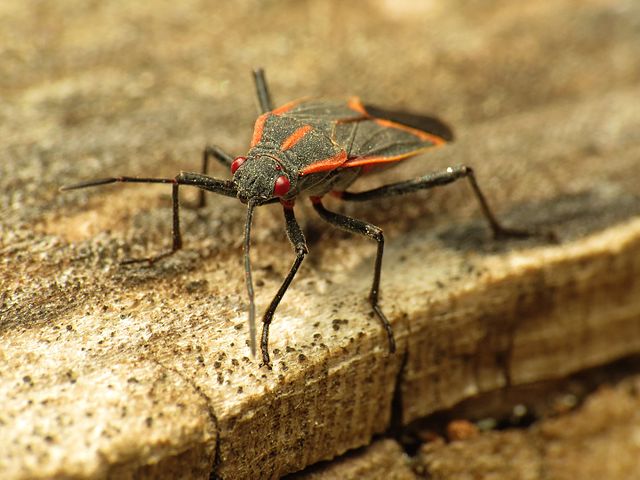This is the second part of a series on winter tree insects. This article examines Asian lady beetle and box elder bug.
Introduction
Through the winter months, plants conserve their energy, often enduring inclement weather in anticipation of spring. Due to the frigid temperatures, many insects enter a state of dormancy, overwintering on or within their hosts. While some insects are visible during winter, others conceal themselves in bark crevices or beneath the soil surface. The following examines some of the most common insects to infest trees during winter, and how they may be observed.
Asian Lady Beetle (Harmonia axyridis)
Asian lady beetle is an exotic beetle in the family Coccinellidae. The insect is native to Asia, where it is widespread. In the 1960s, the United States Department of Agriculture introduced Asian lady beetle to North America in an effort to control several agricultural pests, including aphids, mealybugs, and scale insects. It was first released in Connecticut, Maryland, Pennsylvania, South Carolina, Louisiana, Mississippi, Georgia, Washington, and South Carolina. This practice continued until the 1990s. By this point, the insect had proliferated, becoming established across most of the United States. Asian lady beetle is typically considered a beneficial insect, as it consumes many destructive pests. However, as temperatures drop in fall, the insect can invade households, and other buildings.
Hosts
In Asia, Asian lady beetle typically dwells in forests, fields, and orchards. In the United States and Canada, the insect’s hosts primarily consist of ornamental plants and agricultural crops. Some of the most frequently infested hosts include alfalfa, corn, soybeans, tobacco, and roses.
Symptoms of Infestation
In spring, the adults can be observed wandering on baseboards, windows, walls, attics, light fixtures, ceilings, and other surfaces, as well as on host plants. Asian lady beetle is a relatively benign pest: it will not damage wood, food, or clothing. However, when alarmed, the beetles emit a pungent yellow fluid from their leg joints, which can stain curtains, sheets, and other materials. If the insect makes contact with a human, it may use its mouthparts to bite or pinch bare patches of skin. This can cause minor irritation on the affected area. Interacting with Asian lady beetle may prompt other types of allergic reactions as well, most notably eye irritation. Asian lady beetle is considered a nuisance in the wine industry. If inadvertently processed, the insect can have a deleterious effect on the flavor of the wine.
Management
- Asian lady beetle has a few natural predators that help to limit its populations. The larvae and adults are parasitized by a bevy of tiny wasps and flies.
- Larvae that have not matured by the end of fall will often succumb to sub-freezing temperatures in winter.
- Asian lady beetles can be removed from the interior of buildings with a broom. Gently sweep the beetles into a dustpan or trash container, and place them outdoors. Avoid making fast sweeping motions. If struck violently, the beetles may be prompted to secrete the defensive fluid stored in their leg joints.
- When present, Asian lady beetles can be captured and disposed of using a vacuum cleaner. After vacuuming up the insects, empty vacuum bags and similar attachments outdoors.
- Seal cracks and wall openings to prevent the adults from entering buildings.
- Repair damaged window screens, and ensure that screening is installed behind attic vents.
- Insecticides are not recommended for indoor use, as they tend to be ineffective and costly.
- Residual insecticides can be sprayed on the exterior of buildings to deter the adults. Insecticides should be applied in fall, when the insects are still feeding.
Box Elder Bug (Boisea trivittata)
Box elder bug is a species of true bug in the family Rhopalidae. From spring to fall, box elder bugs congregate on plants, sometimes in large quantities. As temperatures drop in Autumn, box elder bugs will invade households and other buildings, where they can become a nuisance.
Hosts
Box elder bug primarily infests maple and seed-bearing boxelder trees. It also occasionally infests and feeds on the fruit of plum and apple trees.
Symptoms of Infestation
When populations are dense, the nymphs can be observed crawling on the ground, dwelling in gardens, and feeding on the plant material of host trees. Box elder bugs tend to aggregate on the southern and western exposures of tall structures and isolated buildings. As temperatures plummet in fall, the adults may penetrate into the interior of households, and other buildings. If disturbed, box elder bugs will expel a pungent compound, which can leave a reddish-orange stain on walls, curtains, and furniture. The insect’s mouthparts can puncture skin, causing a slight irritation, with a red spot arising in the center of the affected area.
Management
- Repair holes in windows and doors to prevent entry to the adults.
- When the insect is present within a building, avoid fumigating. The husks of the dead insects will attract dermestid beetles, which can be destructive pests.
- Use a broom or a vacuum to remove expired box elder bugs from households. Dispose of them in a trash bag or vacuum bag.
- Residual insecticides can be employed in spring and fall to deter the adults from landing on buildings.
- A solution composed of ½ cup of dish soap and 1 gallon of water can be used to eliminate box elder bugs on plants, and the exterior of buildings.
Courtesy of Katja Schulz CC-by-2.0


